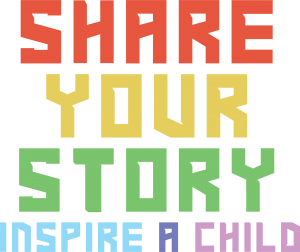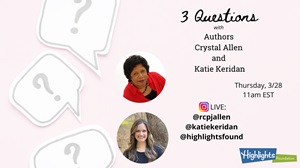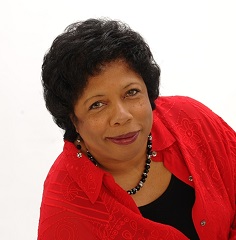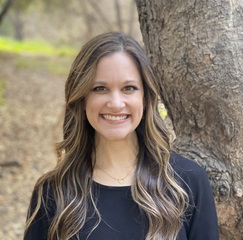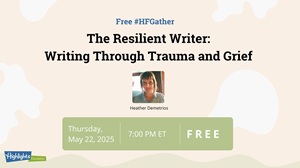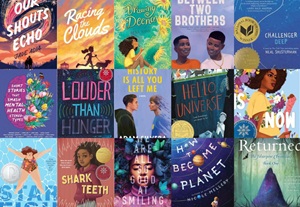Crystal Allen and Katie Keridan joined Highlights Foundation Social Media Manager Cat Galeano on Instagram Live to talk about the mini-course: Writing About Mental Health for MG and YA Readers. Watch the conversation below.
(Please note: closed captions are being added to the video below. When they are finished, you can see them by hovering over the bottom of the video and choosing the “CC” icon.)
Full Transcript:
Cat:
A big hello to our Highlights Foundation family. We’re so happy to have you here with us. For those that may not know me, I’m Cat Galeano, my pronouns are she/her. I’m the social media manager at the Highlights Foundation, joining you from Westchester, New York on the traditional lands of the Seewanoy people. Apart from all the fun things I get to do at the Highlights Foundation, I am also a writer myself and a reader, so I’m very excited to welcome our friends and faculty Crystal Allen and Katie Keridan. They will be teaching the two-night mini Writing About Mental Health for MG and YA Readers: A Two-Night Mini on April 2nd and 4th, AKA next week. So make sure to sign up! But before we dive in, I just wanted to remind our viewers that joining in on any Highlights Foundation sessions, to do so with no hate, no harm and no harassment of any kind. And now let’s get started.
So for my first question, I will let you kind of decide amongst yourselves which which person wants to answer first, but what I most loved is this, this description line that we had on the website. It says writing about mental health topics in this literature can come from a place of both support and empowerment. What’s an example, either from your work or something you’ve read recently, that you think did a good job on both these things?
Katie:
Crystal, why don’t you kick us off?
Crystal:
Sure. And I’m so glad to be hanging out with you again, Katie.
Katie:
I feel the same way!
Crystal:
So let let me just change the wording a little bit here, Cat, if that’s OK.
Cat:
Sure.
Crystal:
Because when I think of the two words support and empowerment, I think of hope and healing. So for me, support is the hope that you’re giving to someone who, um, when you’re working with mental health topics in your story and in real life, actually. And empowerment is where the healing comes. So when you put those two together, then you’re able to show a true picture of someone who is, who is working through a mental health issue or, or is carrying one. So in my story, the support actually came from family and friends and the community, which helped my main character help his brother. He empowered himself by trying to deal with his mental health topic, which is actually shyness. To deal with that, and to realize that his brother needed him to speak out. He empowered himself and also in doing that, he empowered his brother. So those two things are, are really important when it comes to to working with mental health topics. So what do you think, Katie?
Kate:
I could not agree more. I love, I love the idea of hope and healing because for me, when I started the YA trilogy that I’m two books into, I didn’t want to take the more conventional route of: OK my protagonists fall in love, they meet their soulmate and now all their mental health issues are gone, poof! Everything has disappeared. They don’t struggle with anything anymore. That’s not real life.
Crystal:
It’s not, it’s not.
Katie:
Right. So for me, the hope and the healing piece, especially my male main character Sebastian. He has a very, very traumatic background and as a result of this he has a very difficult time trusting people, opening up to people. He has terrible night terrors and nightmares. He’s scared to share a bed. One because he’s afraid he’s gonna wake up in the middle of the night screaming. And what is the person going to think when when they wake up next to someone who’s screaming in the middle of the night? And so his journey, once he finds his soulmate, that’s the beginning of his healing and his hope. And he realizes that he has the ability to make the changes that he wants that are better for him. Not because someone is saying this is how you need to be, but because he wants to become as a person. And like you said, Crystal, he’s able to do that because of the people that are around him. The power’s always been inside of him. He just didn’t know how to access it.
Crystal:
Right, right.
Katie:
Yeah, and that’s the message we really want to give with this, is that there is hope and there is healing and it’s done in community coming from yourself.
Crystal:
Absolutely. Absolutely.
Cat:
That is so special. I’m just like typing away over here, like trying “hope and healing” You know, like if I, if, if you see a graphic with that wording for promotion you, you heard it here first because that is so, so special. Wow. Thank you so much for sharing that.
Uh, now we have to jump into our second question, even though I’m still on “hope and healing.” So that was so moving. My second question is what is a basic example of a consideration that writers should take in writing around this topic? Even when their stories don’t completely center on mental health themes. For example, maybe they’re writing a secondary character versus a main character. Or a particular scene in the larger context of their novel. And do these considerations differ?
Crystal:
OK. you want to start, Katie? Or I can…
Katie:
I’ll jump in with this one. I think for me, whether you’re focusing on a main character with mental health challenges or you’re focusing on a secondary character or a particular scene. Take it seriously. Take it very seriously. Because whether the entire book is about mental health, or there’s just a section in it, that may be someone’s first or only exposure to a mental health challenge that this particular reader has come across. And it’s our responsibility as authors to portray mental health challenges as accurately and as curiously as possible, not only because someone reading our work might personally be impacted or affected by that. But there might be someone who reads it and goes, you know, there’s a person like that in my class and I never thought about that this is what it’s like for them before. Wow, maybe there’s a different way I can reach out to them or try to connect them,you know, try to connect with them.
So for me it’s not about how much space the mental health is taking up in your book. I take it just as seriously whether it’s, it’s the main focus or a small piece, because to do anything less is an injustice to my readers, I believe. And to me, you know, I also always try to write my secondary characters tinking that they’re the main character in the book. Gives them personality, it makes them jump and come alive on the page. And so I think it’s, it’s so important because you never know what reader is going to connect with which character and taking it seriously and really coming from a place of authenticity is, is huge and I would highly encourage authors to really, really consider that when they’re creating these characters and these….
Crystal:
Absolutely. Oh my gosh, Katie, that was amazing. And, and it’s so much truth there. You’re so spot-on with that and I just wanted to add: as you are creating and taking into consideration, please do not forget culture. Do not, not forget identities. Even though mental health manifests in so many different ways, with so many different people, culture is so important because there are just different ways that cultures deal with mental health issues. For instance, when my son obtained an anoxic brain injury, it immediately sent me into a different world. He was no longer on a straight path like my oldest son. He was now in a different world of, of people with autism and people with brain injuries and it was like square pegs trying to fit in a round hole. And so I was trying to understand this world. But what I noticed was there were not many black people outside coming into different places, exposing those with mental health issues to the public and as I continue to bring my son out into the open, so he could re-experience things, my people weren’t out there as much. And I began to look into my own culture and into other cultures to see how they were dealing with mental health issues. This is vital when you are trying to write or if you choose to write about someone with mental health issues. Know the culture. Don’t just know the mental health topic, which is incredibly important. But it is also important to know the culture that you’re writing about.
Cat:
Yeah, I love, I love that you both touched on just like sort of the research phase that goes into, you know, deciding to write a story like this, or an element in your story of, of this magnitude. Whether it be researching mental health specifically or the culture of your character. So I really love that you both touched on that because that is so important and also how lucky are we that there are so many stories now that exist like this? And that people like Katie, you touched on like you’re reading a story and perhaps you never realized your classmate maybe was like that. Or even you as a, as a young adult or a middle schooler thinking, Oh wait, what? Huh. So like the the level of care and research that goes into these stories is so important because truly we are, we are changing lives so to, to, to kind of put that good word out there. But yeah, I think so. So I’m really happy to to hear that you’re both saying that and how, how awesome is that that these books exist in the world now?
And last, our last question already, which I’m sad because I’m like I can hang out with you forever. I’m loving the fact that I get to talk to faculty like right before their “lives,” I mean right before their minis and their courses. Because I’m like, oh, this is so fun. Like it’s just kind of like, like a little party. So I’m so honored to be able to hang out with you.
So our third question is because we were talking about mental health and like, you know, that can be sort of a heavy subject when you’re writing and researching and re-reading. Do you have an example of a self-care method you use when you’re going in to write these big scenes that help you care for the rate, the reader too?
Katie:
Crystal, you want to take that one?
Crystal:
Well, thanks a lot. But I will. You know, I, I, I’ve, I’ve been blessed with humor. And, and it is a gift and and I know that it is. My sister wasn’t. But you know, I was. And when I’m writing, it is important that when I’m writing a big scene, Cat, I need to know where I am going to let my reader exhale. Where I’m going to let my character exhale, and these are things that I set up before I start writing the big scene because for instance, with Between Two Brothers, there were a lot of them. I had a lot of big scenes that were making me spiral, because many of them came from my own truth, and so as I prepared myself to write these scenes, I also had to remember: my reader and my character are going to need opportunities to exhale, to breathe, to enter into the next phase of the story. And me too. So where am I going to put those examples, where am I going to put those possibilities to breathe, and I think about those before I get into the big scene or else I won’t get it finished. I won’t be able to exhale myself, so I make sure that I’m not only thinking about those big scenes, but I’m thinking about how I’m going to bring my reader to the next phase or the next page or the next scene. For me that, that is just so important for self-care. For not just me, and not just my character, but also especially for my reader. What about you, Katie?
Kate:
Wow. How am I going to follow up after that? I love that.
Crystal:
That’s what you get for letting me go first.
Katie:
No, I think that’s there’s so much there, we could spend 30 mMinutes just talking about that. I, I love it. It’s so true, you know. This is something we’re going to get into more in the workshop talking about kind of what is the character and what parts of you are you putting into the character? And I know for myself there’s a lot that I do pull from my own mental health challenges and experiences. And it may not translate directly onto the page, but it’s coming from an authentic place of personal experience and truth. And in order to access that, I really have to kind of beware of how I’m spending my time when I’m…that kind of a section. I’ve learned that I really have to communicate with my husband when I’m in the middle of writing really heavy, you know, scenes or, or revisiting things that I know may trigger things to come back up within myself.
And I didn’t know that as a, as a baby writer when I first started out, you know, you’re clacking away and everything, and then you’re in your head and you…something goes wrong and you’re snapping at someone…you kind of don’t know why or where that’s coming from and so become aware of my own process as I get into writing these types of things helps me be more present it, helps me be authentic and that better allows me to communicate on the page what I want to from the reader so that they feel that and can learn and grow and and feel seen in the book. And then I think equally taking care of myself afterwards, knowing that after I’ve written something where it feels like you’ve just poured your soul out onto this paper, I need some alone time, so I’ll go out in nature, I’ll sit by the creek, I’ll get off social media. I won’t be looking at my phone and just kind of grounding myself and being present and and being able to recognize where I was, where I’ve been, how I’ve grown. I’m not there anymore, thank goodness. But I can take those lessons ad keep moving and sharing. And so it’s, it’s kind of a wrap-around process for me as I’m, as I’m writing these things and the better of the position I’m in is to do that the better service I can do for the reader.
Crystal:
Nice.
Cat:
Yeah. Thank you. I mean the, the, the things you shared about how to connect to the scene and then how to disconnect. I think it’s so important to to share that process with people because there are tough things that you’re writing. And, and you need to take care of yourself so that way you can share that piece for readers. And I love that visual, what Crystal said about the exhaling. Because, Oh my gosh, that I’m, like I like so vividly remember, just like reading things and just like needing to pause. So the fact that you’re thinking about that is ohh like it gave me chills. Like I’m like ohh wow cause it is important. You do need to have that, that breathing room when you’re writing something that’s so heavy. Yeah.
But yeah, we already got a question that said when is the mini starting? So that’s exactly what I’m going to mention next. Thank you for prematurely asking. So now is there anything else you’d like to add before we wrap up?
Katie:
Just that we’re so excited about offering this mini, and the types of things we talked about here today are just a taste of what we’re going to dive into next week. And we can’t wait to share them with people.
Crystal:
So excited.
Cat:
I am so sad I won’t be the person monitoring this class. But like I’ve said before, I’m going to have to also watch this one on my free time because there’s no way I’m missing these two powerhouses teaching together. If you would like to learn more from Crystal and Katie, please make sure to join them next week in Writing About Mental Health for MG and YA Readers: A Two-Night Mini on April 2nd and 4th, which, wildly enough, is next week already. You can register on our website at highlightsfoundation.org or click the link in our bio. And lastly, you can purchase Crystal and Katie’s books at our virtual bookshop, powered by bookshop.org.
Thank you so much, Crystal. Thank you so much, Katie, for joining me today and we can’t wait to see you online.
Crystal:
Thank you. We are so, I am so excited.
Cat:
You’d better sign up people! Thank you everyone. Take care.
Crystal:
Bye.
Katie:
Bye.

